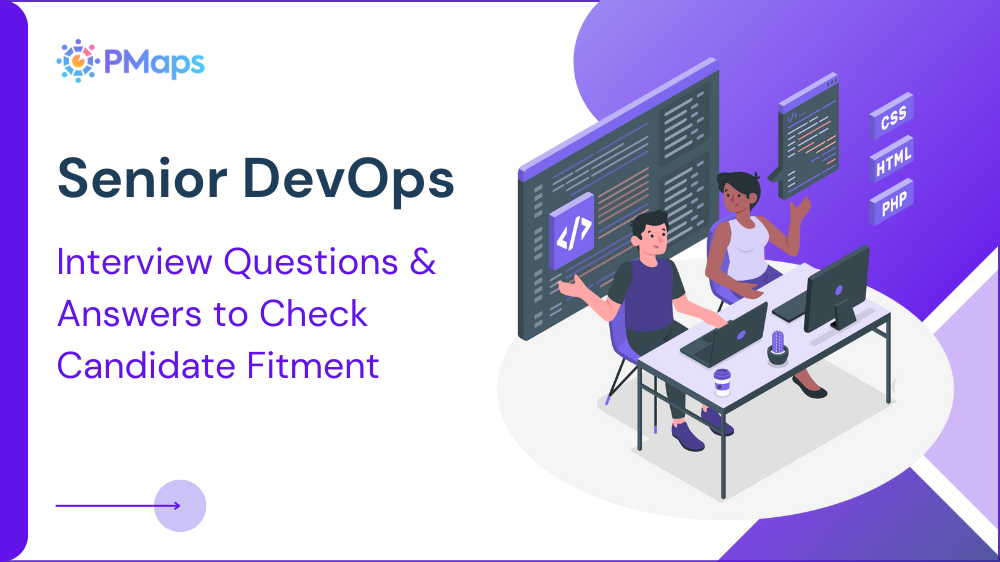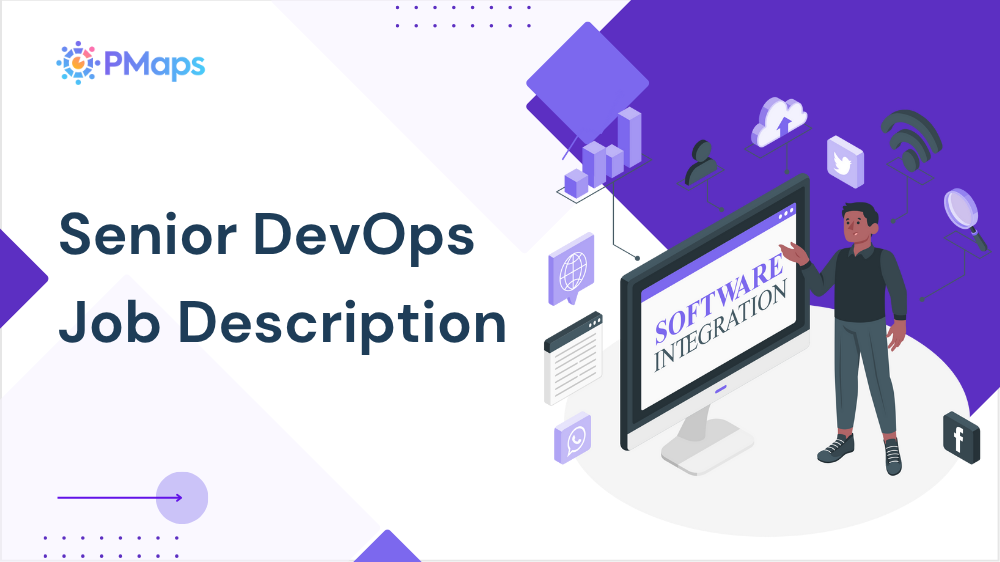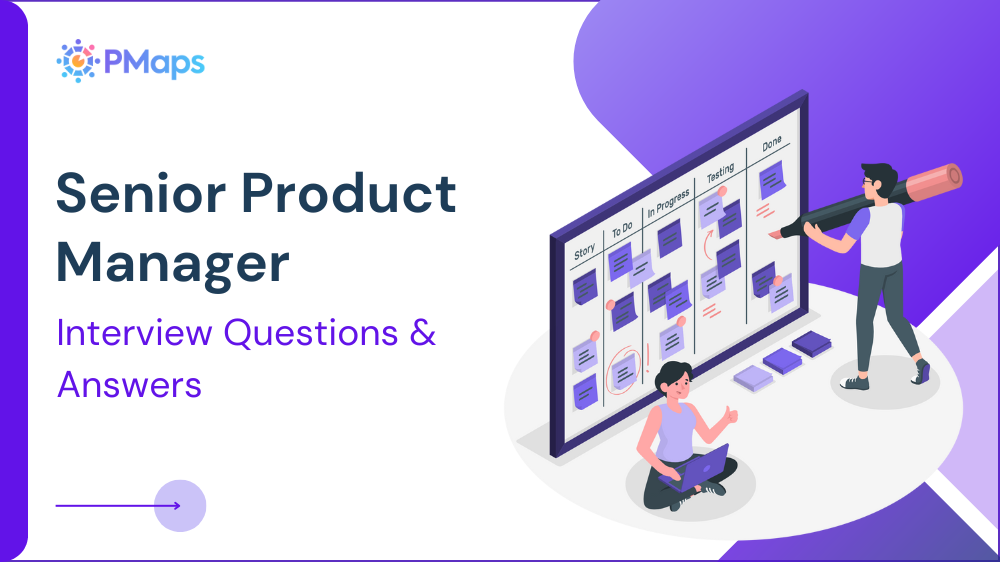
Senior DevOps engineers are the backbone of software delivery pipelines. They architect CI/CD systems, ensure infrastructure scalability, manage incidents, and bridge the gap between dev and ops teams. Hiring for this role goes beyond certifications, it demands insight into problem-solving, reliability, and decision-making under pressure.
This blog features interview questions for senior DevOps engineers, covering general, behavioral, situational, and technical dimensions. Use them to identify candidates with not just the right tools but the right judgment.
You’ve seen the questions. Now confirm skills with the Senior DevOps Assessment.
General Interview Questions for Senior DevOps Engineers
Begin with foundational questions that explore the candidate’s philosophy, communication skills, and practical exposure to DevOps environments. These responses set the tone for whether the candidate operates at a strategic level or just executes tasks on demand.
1. How do you define DevOps, and how has your understanding evolved over time?
What it assesses:
Depth of perspective, real-world exposure, and continuous learning.
What to look for:
A candidate should go beyond textbook definitions. Look for evolution in their thinking — from automation focus to cultural change, collaboration, or metrics-driven delivery.
Sample Answer:
“Early on, I saw DevOps mainly as automating deployments. Over time, I’ve come to see it as a cultural model — aligning dev, QA, and ops around fast, stable delivery. It’s less about tools and more about systems thinking, feedback loops, and reducing friction.”
2. What DevOps tools and platforms have you worked with extensively?
What it assesses:
Toolchain experience and exposure to enterprise-scale environments.
What to look for:
Expect a mix of CI/CD tools (e.g., Jenkins, GitLab CI), IaC (Terraform, Ansible), monitoring (Prometheus, ELK), and cloud platforms (AWS, Azure, GCP). Bonus points if they tailor tools to specific needs rather than name-dropping.
Sample Answer:
“I’ve used Jenkins, GitLab CI, and ArgoCD for pipelines; Terraform and Ansible for provisioning; and Prometheus with Grafana for monitoring. Most of my deployments have been on AWS, but I’ve recently started using GCP for container workloads.”
3. How do you handle version control and branching strategies in fast-moving teams?
What it assesses:
Collaboration practices and Git expertise.
What to look for:
Clear explanation of GitFlow, trunk-based development, or environment-specific branches. They should address merging, rollback, and managing parallel development.
Sample Answer:
“I prefer trunk-based development for smaller teams and GitFlow for more complex environments. Feature branches are short-lived, and we use protected branches with pull requests. I also automate tests on every push to avoid integration headaches.”
4. What is your experience with CI/CD pipelines? Describe a complex one you’ve built.
What it assesses:
Pipeline design, automation depth, and troubleshooting ability.
What to look for:
They should talk through pipeline stages (build, test, deploy), tool integrations, rollback mechanisms, and failure handling. Complex examples often include parallel builds, conditional triggers, or cross-environment deployments.
Sample Answer:
“I designed a multi-stage pipeline in GitLab that runs unit tests, builds Docker images, scans for vulnerabilities, and deploys to staging. On approval, it promotes to production with blue-green deployment. Failures trigger alerts and stop the pipeline.”
5. How do you ensure consistency between development, staging, and production environments?
What it assesses:
Environment parity, configuration management, and deployment discipline.
What to look for:
Look for use of Infrastructure as Code (IaC), containerization, environment variables, and secrets management. They should highlight practices that reduce “works on my machine” issues.
Sample Answer:
“I use Terraform to provision all environments identically and Docker to package apps consistently. Configs are managed via environment variables and secrets stored in Vault. I also run pre-prod sanity checks that mirror production load.”
Behavioral Interview Questions for Senior DevOps Engineers
Behavioral questions reveal how a candidate has acted in previous situations — offering insight into leadership, accountability, and resilience. For senior DevOps engineers, this is where you assess if they’ve owned incidents, led transitions, or handled cross-functional chaos with clarity.
6. Tell me about a time you had to troubleshoot a critical production issue under pressure.
What it assesses:
Incident response, stress handling, and root cause analysis.
What to look for:
They should describe how they isolated the issue, communicated with stakeholders, mitigated impact, and followed up with postmortems. Look for signs of calmness and accountability, not blame.
Sample Answer:
“Our main API started timing out during peak hours. I coordinated with the team to scale the service, reviewed logs in ELK, and discovered DB locks. We applied a patch, updated indexes, and documented the incident in a postmortem. Uptime improved, and we prevented recurrence.”
7. Describe a situation where you had to push back on a release due to deployment risks.
What it assesses:
Risk awareness, decision-making, and communication under pressure.
What to look for:
Candidates should show a willingness to challenge decisions for the right reasons, explain technical trade-offs to non-technical stakeholders, and propose alternative paths.
Sample Answer:
“A release was scheduled on a Friday evening, but testing showed failing rollback scripts. I recommended postponing the release until Monday. I briefed leadership on risks and ran a dry-run during the weekend. It saved us from a potential service disruption.”
8. Have you ever led a DevOps process improvement initiative?
What it assesses:
Initiative, process mindset, and leadership.
What to look for:
Look for examples where they identified bottlenecks, proposed better systems (e.g., pipeline optimization, monitoring upgrade), and influenced adoption across teams.
Sample Answer:
“Our CI pipeline took 25 minutes to complete. I analyzed the process, introduced parallel testing, and moved Docker builds to a faster runner. This brought build time down to 10 minutes and improved dev feedback loops significantly.”
9. Tell me about a time when a deployment went wrong. What did you learn?
What it assesses:
Accountability, learning attitude, and preventive action.
What to look for:
Mature candidates own the mistake, analyze why it happened, and focus on preventing recurrence (e.g., better tests, review policies, or automation).
Sample Answer:
“We deployed a config change that broke authentication. I missed updating the staging environment properly. After rollback, I updated the checklist and introduced a staging verification gate in the pipeline. It hasn’t happened since.”
10. Describe how you’ve handled disagreements with developers or IT over infrastructure decisions.
What it assesses:
Collaboration, negotiation, and team alignment.
What to look for:
They should explain the issue objectively, how they communicated concerns, and how a mutual decision was reached. Good answers show they value long-term harmony over short-term wins.
Sample Answer:
“A developer wanted to bypass load balancers to speed up testing. I explained the risk of environmental drift and performance blind spots. We aligned on a hybrid setup — direct access in dev, full stack in staging. It kept speed without compromising parity.”
Situational Interview Questions for Senior DevOps Engineers
Situational questions assess how a candidate would respond to hypothetical but realistic challenges in complex, fast-paced, or high-risk environments. For senior DevOps engineers, this reveals their ability to think clearly, apply judgment, and manage incidents or transitions with minimal supervision.
11. If a deployment fails during peak business hours, what’s your immediate response?
What it assesses:
Crisis response, prioritization, and rollback strategy.
What to look for:
They should talk about impact analysis, communication with stakeholders, automated rollback, and temporary fixes if needed. Strong candidates follow structured incident handling.
Sample Answer:
“I’d first isolate the issue and check monitoring alerts for scope. Then, I’d initiate rollback if possible, inform key teams via Slack, and update status dashboards. If rollback isn’t clean, I’d apply a hotfix and investigate the root cause post-resolution.”
12. You’re asked to implement a new tool across environments, but your team resists the change. How do you handle it?
What it assesses:
Change management, stakeholder alignment, and influence.
What to look for:
Look for collaboration — not force. Ideal answers involve gathering feedback, running a pilot, and showing data-driven benefits.
Sample Answer:
“I’d start by understanding their concerns — speed, reliability, learning curve. Then I’d run a proof of concept, share performance benchmarks, and offer hands-on demos. Once they saw how it reduced setup time, they were on board.”
13. A developer pushes untested code directly to production. What steps do you take?
What it assesses:
Process enforcement, professionalism, and corrective action.
What to look for:
They should explain how they’d handle the immediate risk and then address the process lapse — without finger-pointing or overreaction.
Sample Answer:
“I’d assess the risk and either roll back or hotfix. Then, I’d address the gap — was it a permissions issue or process oversight? Finally, I’d bring it up in our retro and update access policies or CI checks accordingly.”
14. How would you scale infrastructure for an unexpected traffic surge?
What it assesses:
Scalability planning and reactive architecture thinking.
What to look for:
Expect talk of auto-scaling, load balancing, caching layers, and queue systems. Bonus if they discuss monitoring alerts and rollback buffers.
Sample Answer:
“I’d first use auto-scaling groups and ensure horizontal scalability on stateless services. For DBs, I’d enable read replicas. I’d also implement rate limiting and alerting on key metrics to know when we’re nearing capacity.”
15. A critical alert goes off at 2 AM. You’re on-call. What do you do?
What it assesses:
Ownership, on-call readiness, and escalation process.
What to look for:
Good answers show a clear step-by-step process: acknowledge alert, assess severity, apply fix or escalate, document afterward.
Sample Answer:
“I’d log in immediately, check dashboards like Prometheus or Datadog, and determine if it’s actionable. If critical, I’d resolve or rollback, then inform the team via our alerting channel. I’d also write a postmortem later that day.”
Technical Interview Questions for Senior DevOps Engineers
Senior DevOps engineers are expected to make architecture decisions, manage production-critical environments, and automate complex workflows. These technical questions help validate their practical depth, not just tool usage, but how and why they use them.
16. How do you manage Infrastructure as Code (IaC) in production environments?
What it assesses:
IaC proficiency, change control, and environment consistency.
What to look for:
Candidates should mention tools like Terraform or CloudFormation, GitOps workflows, and drift detection. Look for versioning and review controls before deployment.
Sample Answer:
“I use Terraform for all provisioning and maintaining state files in remote backends like S3 with locking via DynamoDB. All changes go through version-controlled pull requests with peer review. I also run a terraform plan in CI to detect unintended changes.”
17. Explain your container orchestration experience. How do you manage Kubernetes in production?
What it assesses:
Container orchestration, reliability engineering, and scaling knowledge.
What to look for:
Look for Kubernetes, Helm, RBAC policies, service discovery, and monitoring integration. Bonus for mentioning self-healing or blue-green deployments.
Sample Answer:
“I use Kubernetes extensively in production. I manage clusters with Helm, apply RBAC for access control, and configure HPA for scaling. I also integrate Prometheus for metrics and Fluentd for logging, ensuring observability across pods.”
18. How do you implement secure secrets management in CI/CD pipelines?
What it assesses:
Security awareness and pipeline hygiene.
What to look for:
They should avoid hardcoding credentials and mention tools like HashiCorp Vault, AWS Secrets Manager, or GitHub Actions secrets. Look for audit trail practices.
Sample Answer:
“I store secrets in Vault and inject them at runtime via environment variables. They’re never exposed in logs. For GitHub Actions, I use encrypted secrets and mask outputs. Access is role-based and audited through central logging.”
19. What’s your approach to monitoring and alerting in production systems?
What it assesses:
Observability, reliability, and user-impact thinking.
What to look for:
Expect end-to-end monitoring stacks, alert thresholds, and use of tools like Prometheus, ELK, Grafana, or Datadog. Strong answers focus on actionable alerts, not noise.
Sample Answer:
“I use Prometheus with Grafana dashboards and Alertmanager for notifications. We set SLO-based thresholds to avoid alert fatigue. For logs, I use the ELK stack and centralize everything in Kibana for root cause analysis.”
20. How do you ensure zero-downtime deployments?
What it assesses:
Deployment strategy and real-world traffic management.
What to look for:
Look for blue-green, canary, or rolling deployment strategies. They should account for traffic shifting, rollback readiness, and automated health checks.
Sample Answer:
“I implement blue-green deployments using load balancer routing. Once the new version passes health checks, traffic is switched over. If any issue arises, rollback is immediate. For critical microservices, I also use canary rollouts to test incrementally.”
Need a role check? Revisit the Senior DevOps Engineer Job Description before your next step.
Pro Tips for Interviewing Senior DevOps Engineers
Hiring a senior DevOps engineer goes far beyond evaluating tool familiarity. You’re hiring someone who may architect your release pipeline, lead on-call rotations, enforce security practices, and influence your engineering culture. These tips will help you assess candidates on those deeper qualities.
1. Test critical thinking, not just tooling
Most engineers can list tools — but few can justify why they used them. Ask follow-up questions like “Why did you choose this tool over X?” or “What trade-offs did you consider before implementing this?”
2. Use a hands-on technical task
Even a short 60-minute assignment — like setting up a basic CI/CD pipeline, writing a Dockerfile, or debugging a config issue — reveals how a candidate structures work, documents assumptions, and handles edge cases.
3. Simulate incident response scenarios
Give the candidate a mock P1 alert and ask how they’d respond. Look for composure, stepwise thinking, communication strategy, and post-incident cleanup. This highlights leadership and process adherence.
4. Evaluate cross-team collaboration
Ask how they’ve handled conflicts with devs, IT, or security teams. Senior DevOps engineers should balance tech decisions with diplomacy — and explain complex topics to non-technical stakeholders without condescension.
5. Use pre-hire assessments to validate skills
A role-specific senior DevOps test helps validate core competencies like CI/CD configuration, troubleshooting, scripting, and cloud automation — reducing interview guesswork and saving engineering bandwidth.
Conclusion
Hiring a senior DevOps engineer demands clear evidence of judgment, reliability, and hands-on depth—not just tool familiarity. Use these questions, tasks, and simulations to validate real skill. For faster screening, pair senior devops interviews with our senior devops test and refine the role using a tailored senior devops job description. Need help? Call 8591320212 or email assessment@pmaps.in.




.png)

.png)


